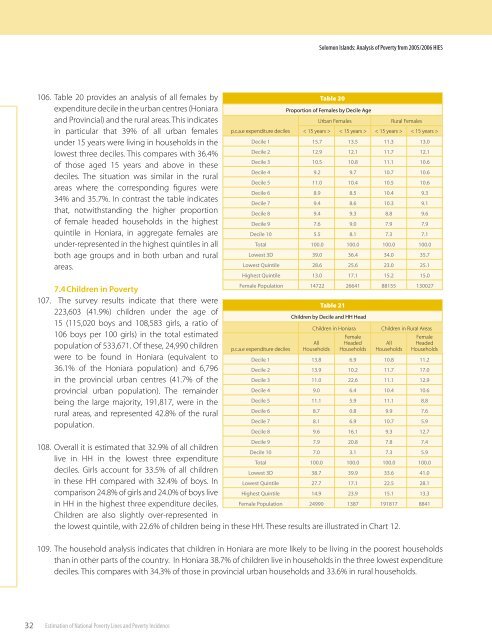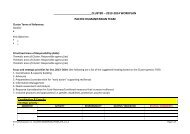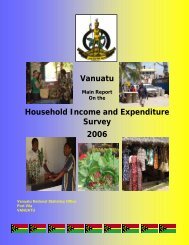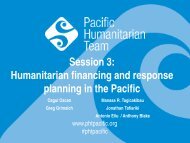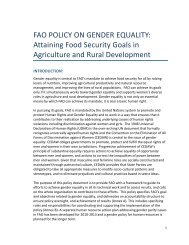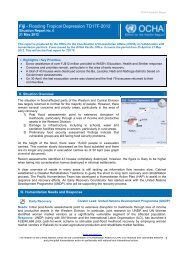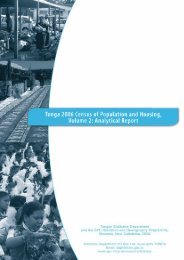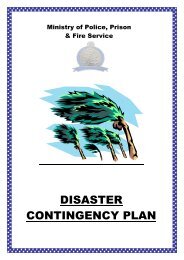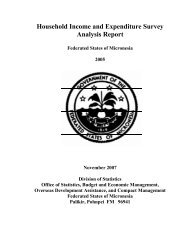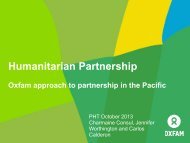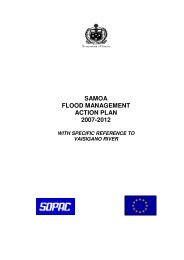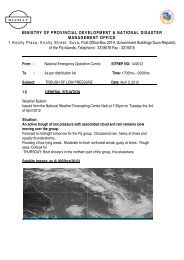Solomon Islands - Asia & the Pacific
Solomon Islands - Asia & the Pacific
Solomon Islands - Asia & the Pacific
Create successful ePaper yourself
Turn your PDF publications into a flip-book with our unique Google optimized e-Paper software.
<strong>Solomon</strong> <strong>Islands</strong>: Analysis of Poverty from 2005/2006 HIES106. Table 20 provides an analysis of all females byexpenditure decile in <strong>the</strong> urban centres (Honiaraand Provincial) and <strong>the</strong> rural areas. This indicatesin particular that 39% of all urban femalesunder 15 years were living in households in <strong>the</strong>lowest three deciles. This compares with 36.4%of those aged 15 years and above in <strong>the</strong>sedeciles. The situation was similar in <strong>the</strong> ruralareas where <strong>the</strong> corresponding figures were34% and 35.7%. In contrast <strong>the</strong> table indicatesthat, notwithstanding <strong>the</strong> higher proportionof female headed households in <strong>the</strong> highestquintile in Honiara, in aggregate females areunder-represented in <strong>the</strong> highest quintiles in allboth age groups and in both urban and ruralareas.7.4 Children in Poverty107. The survey results indicate that <strong>the</strong>re were223,603 (41.9%) children under <strong>the</strong> age of15 (115,020 boys and 108,583 girls, a ratio of106 boys per 100 girls) in <strong>the</strong> total estimatedpopulation of 533,671. Of <strong>the</strong>se, 24,990 childrenwere to be found in Honiara (equivalent to36.1% of <strong>the</strong> Honiara population) and 6,796in <strong>the</strong> provincial urban centres (41.7% of <strong>the</strong>provincial urban population). The remainderbeing <strong>the</strong> large majority, 191,817, were in <strong>the</strong>rural areas, and represented 42.8% of <strong>the</strong> ruralpopulation.108. Overall it is estimated that 32.9% of all childrenlive in HH in <strong>the</strong> lowest three expendituredeciles. Girls account for 33.5% of all childrenin <strong>the</strong>se HH compared with 32.4% of boys. Incomparison 24.8% of girls and 24.0% of boys livein HH in <strong>the</strong> highest three expenditure deciles.Children are also slightly over-represented in<strong>the</strong> lowest quintile, with 22.6% of children being in <strong>the</strong>se HH. These results are illustrated in Chart 12.109. The household analysis indicates that children in Honiara are more likely to be living in <strong>the</strong> poorest householdsthan in o<strong>the</strong>r parts of <strong>the</strong> country. In Honiara 38.7% of children live in households in <strong>the</strong> three lowest expendituredeciles. This compares with 34.3% of those in provincial urban households and 33.6% in rural households.32Estimation of National Poverty Lines and Poverty Incidence


